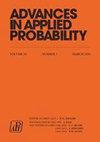Branching processes in random environments with thresholds
IF 1.2
4区 数学
Q3 STATISTICS & PROBABILITY
引用次数: 0
Abstract
Motivated by applications to COVID dynamics, we describe a model of a branching process in a random environment $\{Z_n\}$ whose characteristics change when crossing upper and lower thresholds. This introduces a cyclical path behavior involving periods of increase and decrease leading to supercritical and subcritical regimes. Even though the process is not Markov, we identify subsequences at random time points $\{(\tau_j, \nu_j)\}$ —specifically the values of the process at crossing times, viz. $\{(Z_{\tau_j}, Z_{\nu_j})\}$ —along which the process retains the Markov structure. Under mild moment and regularity conditions, we establish that the subsequences possess a regenerative structure and prove that the limiting normal distributions of the growth rates of the process in supercritical and subcritical regimes decouple. For this reason, we establish limit theorems concerning the length of supercritical and subcritical regimes and the proportion of time the process spends in these regimes. As a byproduct of our analysis, we explicitly identify the limiting variances in terms of the functionals of the offspring distribution, threshold distribution, and environmental sequences.具有阈值的随机环境中的分支过程
受COVID动力学应用的启发,我们描述了随机环境$\{Z_n\}$中的分支过程模型,该模型的特征在跨越上阈值和下阈值时发生变化。这引入了一种循环路径行为,包括导致超临界和亚临界状态的增加和减少周期。即使该过程不是马尔可夫的,我们也识别随机时间点$\{(\tau_j,\nu_j)\}$处的子序列——特别是该过程在交叉时间的值,即$\{。在温和矩和正则性条件下,我们建立了子序列具有再生结构,并证明了超临界和亚临界状态下过程生长速率的极限正态分布解耦。因此,我们建立了关于超临界和亚临界状态的长度以及过程在这些状态下花费的时间比例的极限定理。作为我们分析的副产品,我们明确地确定了子代分布、阈值分布和环境序列的泛函方面的极限方差。
本文章由计算机程序翻译,如有差异,请以英文原文为准。
求助全文
约1分钟内获得全文
求助全文
来源期刊

Advances in Applied Probability
数学-统计学与概率论
CiteScore
2.00
自引率
0.00%
发文量
64
审稿时长
6-12 weeks
期刊介绍:
The Advances in Applied Probability has been published by the Applied Probability Trust for over four decades, and is a companion publication to the Journal of Applied Probability. It contains mathematical and scientific papers of interest to applied probabilists, with emphasis on applications in a broad spectrum of disciplines, including the biosciences, operations research, telecommunications, computer science, engineering, epidemiology, financial mathematics, the physical and social sciences, and any field where stochastic modeling is used.
A submission to Applied Probability represents a submission that may, at the Editor-in-Chief’s discretion, appear in either the Journal of Applied Probability or the Advances in Applied Probability. Typically, shorter papers appear in the Journal, with longer contributions appearing in the Advances.
 求助内容:
求助内容: 应助结果提醒方式:
应助结果提醒方式:


